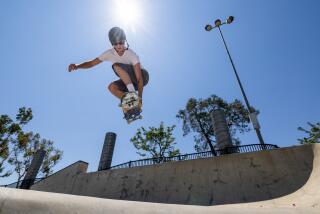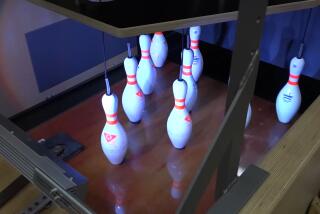The Cutting Edge: COMPUTING / TECHNOLOGY / INNOVATION : For Firmer Grip on Golf: Laser Putting
- Share via
Like many golfers, David Wall had a lot of trouble with his putting. But Wall, who with his brother owns a computer design, sales and distribution company in Albuquerque, N.M., thinks he has found a high-tech answer to his all-too-common putting problems.
Wall has come up with a putter that helps redefine stroke problems on the practice green. His putter is outfitted with a laser mechanism that shoots out a beam of red light. When the putter is properly aligned with the ball, a red dot of light appears on the ball. This lets the golfer see the club face’s position relative to the ball on each part of the stroke.
Wall’s putter, called “Eye of the Zebra,” won’t turn you into Arnold Palmer, and it’s not designed for actual play on the course. But Wall is confident that frustrated golfers will gain skill and assurance practicing with his device.
Wall has licensed his patent to Ram Golf, the most popular maker of putters in the United States, and the company expects to have the club in sporting goods stores and golf pro shops next month.
Priced at $199 to $350, the putter comes with a replaceable battery, a protective head cover, instructions and special protective circuitry that shuts the laser off when the club is in the bag.
Doing the Data Plie: With an eye toward developing tools for video retrieval from large video archives, MIT scientists are teaching a computer to identify dance steps, such as ballet’s plie, from a stream of motion.
The process has two distinct steps. The first, known as geometry extraction, is a well-established computer vision technique and is performed using a commercial system from Adaptive Optics Associates. The Adaptive Optics system collects data about the position of the body in space by using four infrared illumination cameras to photograph a dancer who is wearing markers on her toes, ankles, knees, hips, shoulders, wrists and elbows: the three-dimensional trajectories of the markers generate a geometric model of the dance step.
Next, the computer must understand the sequence of positions as a plie, as well as know the beginning and the end of a given step. The recognition system, developed by Professor Aaron Bobick of MIT’s Media Lab and graduate student Lee Campbell, locates the relative position of one part of the body with respect to another. The system then builds detectors for each step and labels the dance step appropriately. Theoretically, when the system is perfected, it could recognize a video of a hurricane--or a performance by a real ballerina--in the same way.
Rust-Resistant Re-Bar: Reinforcing bar--known commonly as re-bar--is among the cheapest types of steel and is used in virtually every concrete structure in the world. The problem is that re-bar, which is made from scrap metal, eventually corrodes.
A rust-resistant re-bar could save the U.S. billions of dollars now spent to repair or replace concrete bridges and buildings rendered unsafe because their internal skeleton has corroded.
The steel industry has tried to improve the durability of steel by coating re-bar with epoxy resin or zinc. But this has proved to delay the rusting process by only several years at best--and at one and a half to two times the cost of uncoated re-bar.
Now UC Berkeley scientists have developed a corrosion-resistant steel (with the trademark Fermar) especially designed to be rust-resistant when used as re-bar.
The process to make Fermar differs only slightly from that used by American re-bar manufacturers today, yet produces a steel that is much more resistant to corrosion.
The basic problem is that the steel used in re-bar contains microscopic fingers of two different components, ferrite and carbide, which in the presence of an electrolyte--such as a salt solution--behave like a tiny battery. Because concrete is naturally porous, salts seep in and corrosion begins.
The Berkeley scientists reasoned that by keeping the steel rolling process at a constant, controlled temperature and then rapidly quenching the hot steel in water, they could prevent the formation of carbides. Instead, another iron-containing component, martensite, would form alongside the ferrite.
Ferrite and martensite together--hence the name Fermar--do not act as a battery in the presence of salt and moisture.
While U.S. steel mills have been reluctant to alter their rolling process or to add the water-quenching bath at the end of the line, some Japanese, European and Korean steel mills already have these capabilities.
More to Read
Go beyond the scoreboard
Get the latest on L.A.'s teams in the daily Sports Report newsletter.
You may occasionally receive promotional content from the Los Angeles Times.










